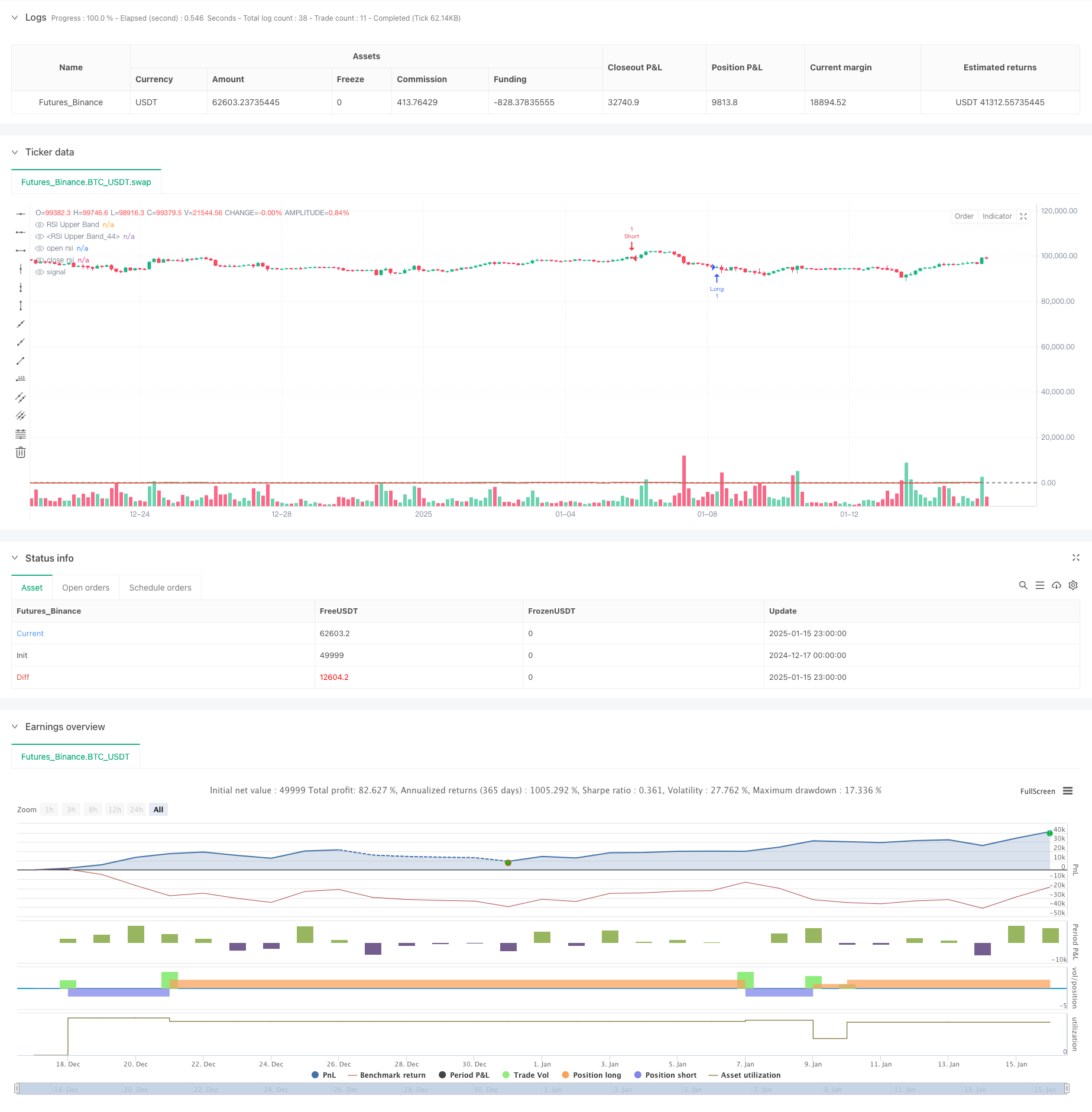
概述
本策略是一个基于双周期RSI(相对强弱指标)的趋势跟踪交易系统,结合了金字塔式加仓管理。策略通过对比两个不同周期(14和30)的RSI指标,在趋势初期介入并在趋势延续时通过限价单进行加仓,实现对趋势的最大化把握。系统设计了完整的风险控制机制,包括仓位管理和动态平仓条件。
策略原理
策略采用双周期RSI交叉信号作为交易触发条件,并结合金字塔式加仓管理。具体来说: 1. 入场信号:使用14周期RSI突破超卖(30)和超买(70)水平作为开仓信号 2. 加仓管理:在开仓后通过设定价格偏离1.5%的限价单实现二次加仓 3. 平仓信号:使用30周期RSI作为平仓指标,当RSI从超买区回落或从超卖区反弹时触发平仓 4. 仓位控制:系统允许最多持有两个头寸(pyramiding=2),每次开仓数量可独立设置
策略优势
- 趋势把握能力强:通过双周期RSI的配合,能够更好地识别和跟踪中长期趋势
- 风险收益比优化:采用金字塔式加仓策略,在趋势确立后通过加仓放大收益
- 灵活的仓位管理:可以根据市场情况和资金量调整开仓和加仓数量
- 动态止损设计:使用长周期RSI作为平仓指标,避免过早离场
- 参数可调性强:主要参数都可以根据不同市场特征进行优化调整
策略风险
- 震荡市场风险:在区间震荡市场中可能频繁进出导致损失
- 滑点风险:加仓订单采用限价单执行,在剧烈行情中可能错过最佳加仓时机
- 资金管理风险:双倍仓位可能带来较大的回撤
- 趋势反转风险:RSI指标具有一定滞后性,可能在趋势反转时未能及时止损
- 参数优化风险:过度优化可能导致策略在实盘中表现不佳
策略优化方向
- 引入趋势过滤器:可以添加均线或者ADX等趋势指标,提高入场信号的可靠性
- 优化仓位管理:可以设计动态的仓位管理系统,根据波动率调整开仓数量
- 完善止损机制:考虑添加跟踪止损或者基于ATR的止损方案
- 增加市场环境过滤:引入波动率指标,在不同市场环境下调整策略参数
- 改进加仓逻辑:可以基于波动率动态调整加仓价格偏离度
总结
该策略通过双周期RSI和金字塔式加仓的结合,实现了对趋势的良好把握。策略设计了完整的交易系统,包括入场、加仓、止损和仓位管理等关键要素。通过参数优化和风险管理的改进,策略有望在实际交易中取得稳定表现。建议交易者在实盘使用前,充分测试并根据具体市场特征调整参数。
策略源码
/*backtest
start: 2024-12-17 00:00:00
end: 2025-01-16 00:00:00
period: 3h
basePeriod: 3h
exchanges: [{"eid":"Futures_Binance","currency":"BTC_USDT","balance":49999}]
*/
//@version=5
strategy("RSI Top Strategy", overlay=true, pyramiding=2)
qty1 = input( 1 , "Qty first entry", group="Strategy settings")
qty2 = input( 1 , "Qty second entry", group="Strategy settings")
avg1 = input.float( 1.5 , "% averaging ", group="Strategy settings")
overSold = input( 30 , group="open RSI Settings")
overBought = input( 70 , group="open RSI Settings")
rsi1len = input.int(14, minval=1, title="open RSI Length", group="open RSI Settings")
overSold2 = input( 30 , group="close RSI Settings")
overBought2 = input( 70 , group="close RSI Settings")
rsi2len = input.int(30, minval=1, title="close RSI Length", group="close RSI Settings")
price = close
vrsi = ta.rsi(price, rsi1len)
vrsi2 = ta.rsi(price, rsi2len)
sz=strategy.position_size
co = ta.crossover(vrsi, overSold)
cu = ta.crossunder(vrsi, overBought)
if (not na(vrsi))
if (co) and not (sz>0)
strategy.entry("Long", strategy.long, qty = qty1, comment="Long")
Avgl=close-close*0.01*avg1
strategy.entry("AvgL", strategy.long, qty = qty2, limit=Avgl, comment="AvgL")
if (cu) and not (sz<0)
strategy.entry("Short", strategy.short, qty = qty1, comment="Short")
Avgs=close+close*0.01*avg1
strategy.entry("AvgS", strategy.short, qty = qty2, limit=Avgs, comment="AvgS")
//plot(strategy.equity, title="equity", color=color.red, linewidth=2, style=plot.style_areabr)
if sz[1]<0 and sz<0 and vrsi2<overBought2 and vrsi2[1]>=overBought2
strategy.close_all("x")
if sz[1]>0 and sz>0 and vrsi2>overSold2 and vrsi2[1]<=overSold2
strategy.close_all("x")
plot(vrsi,'open rsi',color=color.green)
plot(vrsi2,'close rsi',color=color.red)
hline(overBought, "RSI Upper Band", color=#787B86)
hline(overSold, "RSI Upper Band", color=#787B86)
相关推荐